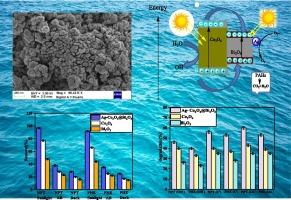Green biosynthesis of Ag-doped hetero-metallic oxide nanocomposite for efficient sunlight-driven photo-adsorptive degradation of carcinogenic naphthalene and phenanthrene
Q1 Environmental Science
Environmental Nanotechnology, Monitoring and Management
Pub Date : 2024-09-19
DOI:10.1016/j.enmm.2024.101008
引用次数: 0
Abstract
One of the most significant issues facing the world today is environmental contamination due to the polycyclic aromatic hydrocarbons, or PAHs release of reactive chemicals into the environment. Here, a green technology was used to synthesis the Ag doped Bi2O3@Co3O4 nanocomposite utilizing an extract from Azadirachta indica leaves. The morphological and structural examination of Ag doped Co3O4@Bi2O3 revealed an image in the form of a hollow spherical or flake adsorbed on a Ag surface with an increase surface area. New peaks in the FT-IR spectra of Ag–O and Co–O–Bi at 678 cm−1 and 1130 cm−1, respectively, show the coupling of Ag. Following this, under various reaction conditions (pollutant: 10–30 mg/L; catalyst: 10–30 mg; pH: 3–11, dark sunlight) the doped nanocomposite was assessed for the efficient removal of NAP and PHE. Ag doped Co3O4@Bi2O3 displayed maximum degradation of NAP (96 %) and PHE (94 %) at 10 mg/L conc. of each PAH with a 25 mg catalytic dose at neutral pH in the presence of direct sunlight. First-order kinetics followed by initial Langmuir adsorption constituted the degradation process. Predominant reactive species and safer metabolite formation in the photocatalysis process of PAHs were studied by scavenger and GC–MS analysis. The green nano photocatalyst that was created demonstrated excellent stability, sensitivity, and reusability (up to 8th cycles) during the degrading process, which likely qualified it for use in industrial uses.

绿色生物合成掺银杂质金属氧化物纳米复合材料,用于在阳光驱动下高效光吸附降解致癌物质萘和菲
当今世界面临的最重要问题之一是由于多环芳烃(PAHs)向环境释放活性化学物质而造成的环境污染。在此,我们采用一种绿色技术,利用 Azadirachta indica 叶子的提取物合成了 Ag 掺杂 Bi2O3@Co3O4 纳米复合材料。通过对掺银 Co3O4@Bi2O3 的形态和结构进行检测,发现其在银表面形成了中空球状或片状吸附图像,且比表面积增大。在 Ag-O 和 Co-O-Bi 的傅立叶变换红外光谱中,分别在 678 cm-1 和 1130 cm-1 处出现了新的峰值,表明了 Ag 的耦合作用。随后,在不同的反应条件下(污染物:10-30 毫克/升;催化剂:10-30 毫克;pH 值:3-11,暗光),对掺杂纳米复合材料高效去除 NAP 和 PHE 的效果进行了评估。掺银 Co3O4@Bi2O3 在中性 pH 值、阳光直射的条件下,当每种多环芳烃的浓度为 10 毫克/升、催化剂剂量为 25 毫克时,NAP(96%)和 PHE(94%)的降解率最高。降解过程为一阶动力学,然后是初始朗缪尔吸附。通过清除剂和气相色谱-质谱分析,研究了多环芳烃光催化过程中的主要反应物和更安全代谢物的形成。所制备的绿色纳米光催化剂在降解过程中表现出卓越的稳定性、灵敏度和可重复使用性(最多可循环使用 8 次),这使其有资格用于工业用途。
本文章由计算机程序翻译,如有差异,请以英文原文为准。
求助全文
约1分钟内获得全文
求助全文
来源期刊

Environmental Nanotechnology, Monitoring and Management
Environmental Science-Water Science and Technology
CiteScore
13.00
自引率
0.00%
发文量
132
审稿时长
48 days
期刊介绍:
Environmental Nanotechnology, Monitoring and Management is a journal devoted to the publication of peer reviewed original research on environmental nanotechnologies, monitoring studies and management for water, soil , waste and human health samples. Critical review articles, short communications and scientific policy briefs are also welcome. The journal will include all environmental matrices except air. Nanomaterials were suggested as efficient cost-effective and environmental friendly alternative to existing treatment materials, from the standpoints of both resource conservation and environmental remediation. The journal aims to receive papers in the field of nanotechnology covering; Developments of new nanosorbents for: •Groundwater, drinking water and wastewater treatment •Remediation of contaminated sites •Assessment of novel nanotechnologies including sustainability and life cycle implications Monitoring and Management papers should cover the fields of: •Novel analytical methods applied to environmental and health samples •Fate and transport of pollutants in the environment •Case studies covering environmental monitoring and public health •Water and soil prevention and legislation •Industrial and hazardous waste- legislation, characterisation, management practices, minimization, treatment and disposal •Environmental management and remediation
 求助内容:
求助内容: 应助结果提醒方式:
应助结果提醒方式:


